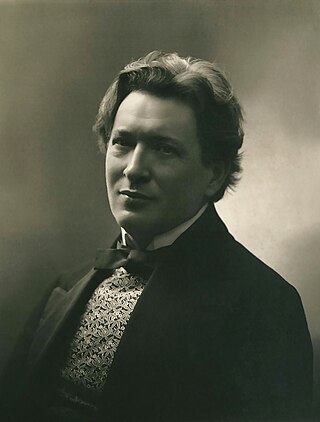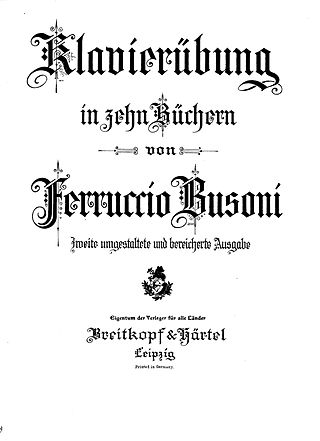
Ferruccio Busoni was an Italian composer, pianist, conductor, editor, writer, and teacher. His international career and reputation led him to work closely with many of the leading musicians, artists and literary figures of his time, and he was a sought-after keyboard instructor and a teacher of composition.

An die Jugend(BV 254) is a sequence of pieces of classical music for solo piano by Ferruccio Busoni.

The Fantasy on Themes from Mozart's Figaro and Don Giovanni, S.697, is an operatic paraphrase for solo piano by Franz Liszt, based on themes from two different Mozart's operas: The Marriage of Figaro, K.492 and Don Giovanni, K.527.

Fantasia contrappuntistica(BV 256) is a solo piano piece composed by Ferruccio Busoni in 1910. Busoni created a number of versions of the work, including several for solo piano and one for two pianos. It has been arranged for organ and for orchestra under the composer's supervision.

The Four Pieces for Piano Op. 119, are four character pieces for piano composed by Johannes Brahms in 1893. The collection is the last composition for solo piano by Brahms. Together with the six pieces from Op. 118, Op. 119 was premiered in London in January 1894.

Sechs kleine Klavierstücke, Op. 19 is a set of pieces for solo piano written by the Austrian composer Arnold Schoenberg, published in 1913 at Universal Edition in Vienna.

The Piano Concerto in C major, Op. 39 (BV 247), by Ferruccio Busoni, is one of the largest works ever written in this genre. Completed and premiered in 1904, it is about 70 minutes long and laid out in five movements played without a break; in the final movement a quiet men's chorus intones words from the verse-drama Aladdin by Adam Oehlenschläger.

Turandot(BV 273) is a 1917 opera with spoken dialogue and in two acts by Ferruccio Busoni. Busoni prepared his own libretto, in German, based on the play of the same name by Count Carlo Gozzi. The music for Busoni's opera is based on the incidental music, and the associated Turandot Suite, which Busoni had written in 1905 for a production of Gozzi's play. The opera is often performed as part of a double bill with Busoni's earlier one-act opera Arlecchino.
Antony Beaumont is an English and German musicologist, writer, conductor and violinist. As a conductor, he has specialized in German music from the first half of the 20th century, including works by Zemlinsky, Weill, and Gurlitt. As a musicologist, he has published books on Busoni, Zemlinsky, and Mahler.

Ferruccio Busoni discography is a list of recordings of music composed or adapted by Ferruccio Busoni. For recordings of music with Busoni as pianist, see Ferruccio Busoni discography.

The Klavierübung, by the Italian pianist-composer Ferruccio Busoni, is a compilation of piano exercises and practice pieces, comprising transcriptions of works by other composers and original compositions of his own.

The Bach-Busoni Editions are a series of publications by the Italian pianist-composer Ferruccio Busoni (1866–1924) containing primarily piano transcriptions of keyboard music by Johann Sebastian Bach. They also include performance suggestions, practice exercises, musical analysis, an essay on the art of transcribing Bach's organ music for piano, an analysis of the fugue from Beethoven's 'Hammerklavier' sonata, and other related material. The later editions also include free adaptations and original compositions by Busoni which are based on the music of Bach.

The Turandot Suite, Op. 41 is an orchestral work by Ferruccio Busoni written in 1904–5, based on Count Carlo Gozzi's play Turandot. The music – in one form or another – occupied Busoni at various times between the years 1904–17. Busoni arranged the suite from incidental music which he was composing to accompany a production of Gozzi's play. The suite was first performed on 21 October 1905, while the play with his incidental music was not produced until 1911. In August 1916 Busoni had finished composing the one-act opera Arlecchino, but it needed a companion work to provide a full evening's entertainment. He suddenly decided to transform the Turandot music into a two-act opera with spoken dialog. The two works were premiered together as a double-bill in May 1917.

Gregorio Nardi is an Italian pianist and musicologist.
Berceuse élégiaque, Op. 42 (BV 252a), is an orchestral work composed by Ferruccio Busoni in 1909. Originally written for solo piano, to be added as the seventh piece in his 1907 collection Elegies, Busoni adapted it for orchestra later the same year. This orchestral version was sub-titled "Des Mannes Wiegenlied am Sarge seiner Mutter". The first performance of Berceuse élégiaque was in New York City on February 21, 1911, and was conducted by Gustav Mahler in his last concert concert before his death.
Wilhelm Mayer was an Austro-Bohemian composer who published his works under the name W. A. Rémy. He was also a noted teacher, whose pupils included Ferruccio Busoni and Felix Weingartner. His name sometimes appears as Wilhelm Mayer-Rémy.

Ferruccio Busoni composed his Concerto for Piano and String Quartet in D minor, Op. 17, BV 80, in 1878, at the age of twelve. The original title was Concerto per piano-forte con accompagnamento di quartetto ad arco, Op. 17. Conceived for string quartet, the piano can also be accompanied by a string orchestra as Concerto for Piano and Strings, the title under which it was published in 1987.













